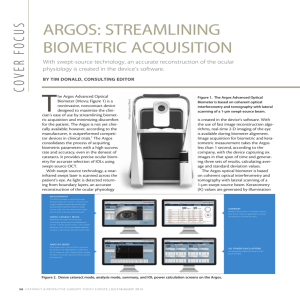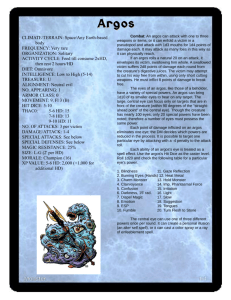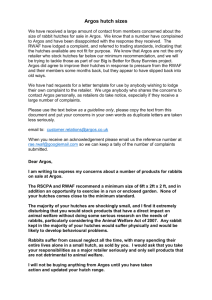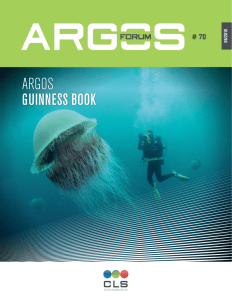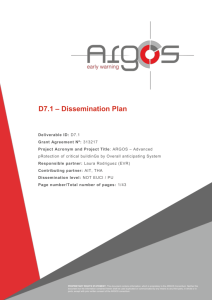ARGOS-CE-ver1.3. CODE-201510-DO-KN-CPY(1009) - oftis
advertisement
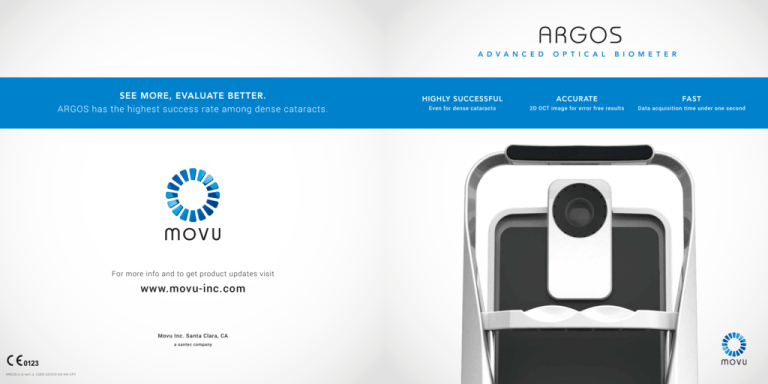
A D V A N C E D For more info and to get product updates visit www.movu-inc.com Movu Inc. Santa Clara, CA a santec company A RGO S - C - E -ver1.3. C ODE -201510 - D O - K N - CPY O P T I C A L B I O M E T E R HIGHLY SUCCESSFUL ACCURATE FAST Even for dense cataracts 2D OCT image for error free results Data acquisition time under one second The ARGOS Optical Biometer obtains precise MEASURES 9 PARAMETERS IN LESS THAN 1 SECOND ocular biometry and performs calculations for Image acquisition for biometry and keratometry takes less than 1 second. ARGOS captures 6 images accurate selection of IOLs (intraocular lens). in less a second and outputs 3 sets of results with calculated average and standard deviation values. This device uses SS-OCT (swept-source Speed and accuracy with ARGOS optical coherence tomography) to deliver the highest success rate and accuracy, even among the densest of cataracts. A non-invasive, non-contact optical biometer, ARGOS BIOMETRIC PARAMETERS CAPTURED BY ARGOS outperformed its competitors in clinical trials. Axial length 1 Corneal thickness 2 Anterior chamber depth 3 Lens thickness 4 Pupil size 5 White-to-white(Corneal diameter) 6 Flat Meridian 7 Steep Meridian 8 Astigmatism 9 HIGHEST SUCCESS RATE FOR DENSE CATARACTS Initial studies of dense cataract result in higher success rate using ARGOS compared to the leading competition. The OCT technique used in ARGOS has an intrinsic advantage of 100x greater sensitivity over other light based 6 5 1 2 3 4 8 biometers. Get it right the first time with ARGOS 9 7 ALL INFRARED (IR) LIGHT, NO 2D WHOLE-EYE IMAGING BASED ON HARSH ILLUMINATION SS-OCT TECHNOLOGY Keratometry is performed by using a ring of Intuitive 2D OCT imaging provides high 16 IR LEDs. Using the reflected image in confidence in accuracy. Using the reflected combination with the OCT signal provides image from a ring of 16 IR LEDs in accurate corneal curvature results. combination with the OCT signal Minimize patient discomfort with ARGOS provides accurate corneal curvature results. See more, evaluate better with ARGOS 01 MEASUREMENT The ARGOS biometer is controlled through Windows-based user interface. The technician is easily guided to reach alignment through Doe, John tracking markers and the unique 2D image window guide. Accurate measurements begin SUMMARY with the touch of joystick-mounted button. Biometry values output in convenient ready to print format. Alerts are generated for unusual discrepancies in OD and OS values. ENHANCED RETINAL VISUALIZATION ARGOS has 10x higher sensitivity than conventional partial coherence reflectometry devices. In Enhanced Retinal Visualization mode (ERV), it can increase sensitivity up to 100x for axial length detection, resulting in significantly improved success rates. Doe, John ANALYSIS MODE After measurement, the technician can assess the validity of the measurement by referring to the 2D image and signal. Analysis Mode includes the option to manually adjust boundary positions for fine tuning. 03 IOL POWER CALCULATIONS IOL calculations made with choice of 6 IOL power formulas. OVERVIEW SPECIFICATIONS TECHNOLOGIES Function Measurement Method Technology Speed Biometry Coherent optical Swept source 0.6 second acquisition time interferometry/tomography Lateral beam scanning for 1 set of measurement Ring LED illumination Infrared LED 3 second output time Parameter Symbol Range In-vivo repeatability(SD) * Corneal thickness CCT 300 - 800 μm <10 µm Anterior Chamber Depth ACD 1.5 - 5.0 mm 10 µm Lens thickness LT 0.5 - 6.5 mm 20 µm Axial Length AL 15 - 30 mm 10 µm Radii of flat and steep meridians (K-reading) R1 , R 2 (K1, K2) 5.5 - 10 mm (60D - 34D) (0.13 D) White-to-white (Corneal diameter) CD 7 - 15 mm 60 µm Pupil size PS 2 - 13 mm 90 µm Astigmatism AST 0 - 180 dec 5 deg (for Cylinder >1D) Value Notes Keratometry MEASUREMENT Integrated double chin rest Chin rest adjustment dial Joystick/Measurement button UNIT UNIT KEY SUMMARY Laser Class Optical Biometer based on 1 micron Swept Source Optical Coherence Tomography Dimensions 310(W)x485(D)x495(H)mm Video Keratometry with IR LED ring illumination Weight 21kg (not including cables) Corneal thickness, Anterior Chamber Depth, Lens thickness, Axial Length, Radii of flat and steep Power Supply for Device 24 V DC meridians (K-reading), White-to-white (Corneal diameter), Pupil size, Astigmatism Power Supply for AC Adapter 100 - 240 V AC 50/60 Hz IOL Formulas Haigis, HofferQ, Holladay1, SRK/T, Shammas No-History PC Intel Core i5 or greater IOL Library Manufacturer’s data uploadable from ULIB (User Group for Laser Interference Biometry) library source 8 GB RAM memory Peripherals Desktop PC (refer to requirements on next page) 500 GB storage Display Resolution 1600x900 pixel ( or greater) Windows 7 Professional Technology Parameters Daily calibration fixture 05 Monitor EN60601-1 Compliant 1600x900 pixel ( or greater) *Data source for obtaining the above in-vivo repeatability The clinical study for quantifying in vivo repeatability was approved by an Institutional Review Board. The study was planned and conducted as a prospective, comparative study. In-vivo repeatability study was performed and analyzed for 43 healthy eyes with 3 acquisitions per eye. The repeatability of axial length measurement may be different in eyes with cataracts. 20 µm
